A GIS-Based Framework for Evaluating Technical and Economic Prospects of Onshore Wind Energy: Case Study of Poland
Abstract
1. Introduction
1.1. Related Research
1.2. Research Aim, Questions, and Contributions
- In countries where regulatory frameworks lag behind the pace required for decarbonization, how do distance restrictions between wind turbines and residential areas affect the development potential of onshore wind energy?
- How does the selection of turbine technology influence the technical potential of wind energy?
- How does the cost of energy production evolve with technological advancements and under varying regulatory conditions?
- It develops a GIS-based framework that supports land-use planning and infrastructure development through the assessment of land eligibility and the identification of suitable wind turbine locations. The framework estimates installable capacity and energy output while accounting for future turbine specifications (rotor size) and wind conditions (prevailing wind direction).
- It integrates an economic feasibility component based on a Levelized Cost of Energy (LCOE) formulation that is methodologically robust, scalable across regions, and suitable for evaluating the financial performance of onshore wind energy within spatially eligible areas.
- It demonstrates the proposed framework through a national-scale case study of Poland, analyzing multiple scenarios to quantify the share of eligible land, potential turbine numbers, total installable capacity, annual energy generation, and corresponding LCOE values.
2. Materials and Methods
2.1. Computational Framework
2.2. Study Area
2.3. Datasets
2.4. Scenarios
3. Results
3.1. Land Eligibility
3.2. Number of Placements, Capacity and Energy Generation Potential
3.3. LCOE
4. Conclusions
Author Contributions
Funding
Data Availability Statement
Acknowledgments
Conflicts of Interest
Abbreviations
| AEP | Annual Energy Production |
| AHP | Analytic Hierarchy Process |
| BDOT10k | Topographic Object Database |
| CAPEX | Capital Expenditures |
| CF | Capacity Factor |
| CRF | Capital Recovery Factor |
| EU | European Union |
| ENTSO-E | European Network of Transmission System Operators for Electricity |
| ENTSOG | European Network of Transmission System Operators for Gas |
| FCR | Fixed Charge Rate |
| GDEP | General Directorate for Environmental Protection |
| GIS | Geographic Information System |
| GLAES | Geospatial Land Availability for Energy Systems |
| IEA | International Energy Agency |
| IEC | International Electrotechnical Commission |
| LCOE | Levelized Cost of Energy |
| MPZP | Local Development Plan |
| NECP | National Energy and Climate Plan |
| OPEX | Operational Expenditures |
| PV | Photovoltaic |
| ProFinFactor | Project Finance Factor |
| RES | Renewable Energy Source |
| TOPSIS | Technique for Order Preference by Similarity to an Ideal Solution |
| TYNDP | Ten-Year Network Development Plan |
| UE | European Union |
Appendix A
| Symbol | Description |
|---|---|
| D | Rotor diameter of the selected turbine class (m) |
| H | Hub height of the selected turbine class (m) |
| C | Rated electrical capacity of the selected turbine class (MW) |
| Multipliers defining turbine spacing along prevailing and crosswind directions | |
| Turbine spacing in prevailing-wind direction: | |
| Turbine spacing in crosswind direction: | |
| Dataset being pre-processed in QGIS (vector or raster) | |
| L | Exclusion layer (vector) after QGIS harmonization |
| Scenario-dependent buffer distance applied to exclusion layer L | |
| Buffered version of exclusion layer L using GLAES | |
| Rasterized exclusion mask corresponding to (100 m resolution) | |
| Land-eligibility mask (binary raster), eligible, excluded | |
| W | Wind-speed raster used for minimum wind constraint (4 m/s) |
| Regular point grid generated from spacing rules | |
| p | Candidate turbine point in the grid |
| Final turbine layout (set of feasible turbine positions) | |
| Capacity factor sampled at turbine location t | |
| Capacity factor value for turbine t | |
| Rated capacity of turbine t (MW), equals C for all turbines in a scenario | |
| Annual energy production of turbine t (MWh/yr) | |
| Levelized cost of energy for individual turbine t (EUR/MWh) | |
| List of all turbine-level LCOE values | |
| Total installed capacity for a scenario (MW) | |
| Total annual energy production for a scenario (MWh) | |
| Average LCOE over all turbines in scenario (EUR/MWh) |
| Algorithm A1 Pre-processing and Land Eligibility |
|
| Algorithm A2 Turbine Allocation Using Spacing Rules |
|
| Algorithm A3 Techno-Economic Assessment |
|
References
- International Energy Agency (IEA). Net Zero by 2050: A Roadmap for the Global Energy Sector; Technical Report; International Energy Agency: Paris, France, 2021. [Google Scholar]
- ENTSO-E; ENTSOG. TYNDP 2024: Scenario Results; Technical Report; European Network of Transmission System Operators for Electricity (ENTSO-E) and European Network of Transmission System Operators for Gas (ENTSOG): Brussels, Belgium, 2024; Available online: https://2024.entsos-tyndp-scenarios.eu/scenario-results/ (accessed on 24 November 2025).
- Weisenfeld, U.; Rollert, K.E. Explaining energy transition: A systemic social mechanisms approach illustrated with the examples of Germany and Poland. Energy Res. Soc. Sci. 2024, 112, 103512. [Google Scholar] [CrossRef]
- Malec, M. The prospects for decarbonisation in the context of reported resources and energy policy goals: The case of Poland. Energy Policy 2022, 161, 112763. [Google Scholar] [CrossRef]
- An, K.; Zheng, X.; Shen, J.; Xie, C.; Wang, C.; Cai, W.; Bu, C. Repositioning coal power to accelerate net-zero transition of China’s power system. Nat. Commun. 2025, 16, 2311. [Google Scholar] [CrossRef]
- International Renewable Energy Agency (IRENA). Renewable Power Generation Costs in 2024; Technical Report; International Renewable Energy Agency: Masdar City, United Arab Emirates, 2025. [Google Scholar]
- Kim, J.; Jaumotte, F.; Panton, A.J.; Schwerhoff, G. Energy security and the green transition. Energy Policy 2025, 198, 114409. [Google Scholar] [CrossRef]
- Zupok, S.; Chomać-Pierzecka, E.; Dmowski, A.; Dyrka, S.; Hordyj, A. A Review of Key Factors Shaping the Development of the U.S. Wind Energy Market in the Context of Contemporary Challenges. Energies 2025, 18, 4224. [Google Scholar] [CrossRef]
- Ryberg, D.S.; Tulemat, Z.; Stolten, D.; Robinius, M. Uniformly constrained land eligibility for onshore European wind power. Renew. Energy 2020, 146, 921–931. [Google Scholar] [CrossRef]
- Jung, C.; Schindler, D. Distance to power grids and consideration criteria reduce global wind energy potential the most. J. Clean. Prod. 2021, 317, 128472. [Google Scholar] [CrossRef]
- Demir, A.; Dincer, A.; Ciftci, C.; Gulcimen, S.; Uzal, N.; Yilmaz, K. Wind farm site selection using GIS-based multicriteria analysis with Life cycle assessment integration. Earth Sci. Inform. 2024, 17, 1591–1608. [Google Scholar] [CrossRef]
- Liu, T.; Zhang, T.; Zou, Y.; Wang, G.; Dai, H.; Zhang, W. Suitability analysis for implementing wind and solar farms based AHP method: Case study in Inner Mongolia, China. Int. Arch. Photogramm. Remote Sens. Spat. Inf. Sci. 2024, XLVIII-1-2024, 417–423. [Google Scholar] [CrossRef]
- Sun, Y.; Li, Y.; Wang, R.; Ma, R. Modelling potential land suitability of large-scale wind energy development using explainable machine learning techniques: Applications for China, USA and EU. Energy Convers. Manag. 2024, 302, 118131. [Google Scholar] [CrossRef]
- Rediske, G.; Burin, H.; Rigo, P.; Rosa, C.; Michels, L.; Siluk, J. Wind power plant site selection: A systematic review. Renew. Sustain. Energy Rev. 2021, 148, 111293. [Google Scholar] [CrossRef]
- Benti, N.E.; Alemu, Y.B.; Balta, M.M.; Gunta, S.; Chaka, M.D.; Semie, A.G.; Mekonnen, Y.S.; Yohannes, H. Site suitability assessment for the development of wind power plant in Wolaita area, Southern Ethiopia: An AHP-GIS model. Sci. Rep. 2023, 13, 19811. [Google Scholar] [CrossRef] [PubMed]
- McKenna, R.; Pfenninger, S.; Heinrichs, H.; Schmidt, J.; Staffell, I.; Bauer, C.; Gruber, K.; Hahmann, A.N.; Jansen, M.; Klingler, M.; et al. High-resolution large-scale onshore wind energy assessments: A review of potential definitions, methodologies and future research needs. Renew. Energy 2022, 182, 659–684. [Google Scholar] [CrossRef]
- Sliz-Szkliniarz, B.; Vogt, J. GIS-based approach for the evaluation of wind energy potential: A case study for the Kujawsko–Pomorskie Voivodeship. Renew. Sustain. Energy Rev. 2011, 15, 1696–1707. [Google Scholar] [CrossRef]
- Świdyńska, N.; Witkowska-Dąbrowska, M.; Jakubowska, D. Influence of Wind Turbines as Dominants in the Landscape on the Acceptance of the Development of Renewable Energy Sources in Poland. Energies 2024, 17, 3268. [Google Scholar] [CrossRef]
- Woźniak, M. Landscape Protection vs. Onshore Wind Energy Investments in Poland—A Legal Perspective. Int. J. Semiot. Law 2025, 38, 1199–1218. [Google Scholar] [CrossRef]
- Ryberg, D.S.; Caglayan, D.G.; Schmitt, S.; Linßen, J.; Stolten, D.; Robinius, M. The future of European onshore wind energy potential: Detailed distribution and simulation of advanced turbine designs. Energy 2019, 182, 1222–1238. [Google Scholar] [CrossRef]
- Fotsing Metegam, I.F.; Bomeni, I.Y.; Chara-Dackou, V.S.; Njomo, D.; Tchinda, R. Technical and geographic potential analysis for large-scale wind energy production using a GIS-AHP multi-criteria in Cameroon. Results Eng. 2024, 24, 102765. [Google Scholar] [CrossRef]
- Langer, J.; Zaaijer, M.; Quist, J.; Blok, K. Introducing site selection flexibility to technical and economic onshore wind potential assessments: New method with application to Indonesia. Renew. Energy 2023, 202, 320–335. [Google Scholar] [CrossRef]
- Ji, L.; Li, J.; Sun, L.; Wang, S.; Guo, J.; Xie, Y.; Wang, X. China’s onshore wind energy potential in the context of climate change. Renew. Sustain. Energy Rev. 2024, 203, 114778. [Google Scholar] [CrossRef]
- McKenna, R.; Hollnaicher, S.; Ostman v. d. Leye, P.; Fichtner, W. Cost-potentials for large onshore wind turbines in Europe. Energy 2015, 83, 217–229. [Google Scholar] [CrossRef]
- Pelczar, S. Assessment of the theoretical potential of onshore wind power plants in Poland in the context of the required distance from residential buildings. Sustain. Energy Technol. Assess. 2025, 75, 104250. [Google Scholar] [CrossRef]
- Amsharuk, A.; Łaska, G. Site Selection of Wind Farms in Poland: Combining Theory with Reality. Energies 2024, 17, 2635. [Google Scholar] [CrossRef]
- Sliz-Szkliniarz, B.; Eberbach, J.; Hoffmann, B.; Fortin, M. Assessing the cost of onshore wind development scenarios: Modelling of spatial and temporal distribution of wind power for the case of Poland. Renew. Sustain. Energy Rev. 2019, 109, 514–531. [Google Scholar] [CrossRef]
- Benalcazar, P.; Komorowska, A.; Kamiński, J. A GIS-based method for assessing the economics of utility-scale photovoltaic systems. Appl. Energy 2024, 353, 122044. [Google Scholar] [CrossRef]
- Stehly, T.; Duffy, P.; Mulas Hernando, D. Cost of Wind Energy Review, 2024 ed; Technical Report; National Renewable Energy Laboratory (NREL): Golden, CO, USA, 2024. [Google Scholar] [CrossRef]
- National Renewable Energy Laboratory (NREL). Equations & Variables—Annual Technology Baseline (ATB) 2024. 2022. Available online: https://atb.nrel.gov/electricity/2024/equations_%26_variables (accessed on 23 October 2025).
- McKenna, R.; Ryberg, D.; Staffell, I.; Hahmann, A.; Schmidt, J.; Heinrichs, H.; Höltinger, S.; Lilliestam, J.; Pfenninger, S.; Robinius, M.; et al. On the socio-technical potential for onshore wind in Europe: A response to Enevoldsen et al. (2019), Energy Policy, 132, 1092-1100. Energy Policy 2020, 145, 111693. [Google Scholar] [CrossRef]
- Enevoldsen, P.; Permien, F.H.; Bakhtaoui, I.; von Krauland, A.K.; Jacobson, M.Z.; Xydis, G.; Sovacool, B.K.; Valentine, S.V.; Luecht, D.; Oxley, G. On the socio-technical potential for onshore wind in Europe: A response to critics. Energy Policy 2021, 151, 112147. [Google Scholar] [CrossRef]
- Watson, S.; Moro, A.; Reis, V.; Baniotopoulos, C.; Barth, S.; Bartoli, G.; Bauer, F.; Boelman, E.; Bosse, D.; Cherubini, A.; et al. Future emerging technologies in the wind power sector: A European perspective. Renew. Sustain. Energy Rev. 2019, 113, 109270. [Google Scholar] [CrossRef]
- Benalcazar, P. Optimal sizing of thermal energy storage systems for CHP plants considering specific investment costs: A case study. Energy 2021, 234, 121323. [Google Scholar] [CrossRef]
- Head Office of Geodesy and Cartography (GUGiK). Baza Danych Obiektów Topograficznych—BDOT10k. 2025. Available online: https://www.geoportal.gov.pl/pl/dane/baza-danych-obiektow-topograficznych-bdot10k/ (accessed on 23 October 2025).
- Fundacja Instrat. Zainstalowana Moc Źródeł Energii Elektrycznej w Polsce—Dane ARE. 2025. Available online: https://energy.instrat.pl/system-elektroenergetyczny/zainstalowana-moc-are/ (accessed on 23 October 2025).
- Sejm Rzeczypospolitej Polskiej. Druk nr 1130—Sejm X kadencji: Projekt Ustawy o Zmianie Ustawy o Środkach Wspierania… [Złagodzenie Minimalnej Odległości Elektrowni Wiatrowych]. 2025. Available online: https://www.sejm.gov.pl/sejm10.nsf/PrzebiegProc.xsp?nr=1130 (accessed on 23 October 2025).
- Rzeczpospolita Polska—Ministerstwo Klimatu i Środowiska. Projekt Krajowego Planu w Dziedzinie Energii i Klimatu do 2030 r. z Perspektywa˛ do 2040 r. (Wersja Przekazana do Dalszego Procedowania na Poziomie Rady Ministrów). 2024. Available online: https://www.gov.pl/web/klimat/projekt-krajowego-planu-w-dziedzinie-energii-i-klimatu-do-2030-r-z-perspektywa-do-2040-r-wersja-przekazana-do-dalszego-procedowania-na-poziomie-rady-ministrow (accessed on 23 October 2025).
- Informatyczny System Osłony Kraju. Usługa Pobierania INSPIRE. 2025. Available online: https://isok.gov.pl/inspire.html (accessed on 23 October 2025).
- Eurostat. EU-DEM Digital Elevation Model. 2025. Available online: https://ec.europa.eu/eurostat/web/gisco/geodata/digital-elevation-model/eu-dem, (accessed on 23 October 2025).
- Generalna Dyrekcja Ochrony Środowiska. Dostęp do Danych Geoprzestrzennych. 2025. Available online: https://www.gov.pl/web/gdos/dostep-do-danych-geoprzestrzennych, (accessed on 23 October 2025).
- DTUWind Energy; World Bank Group. Global Wind Atlas 3.0; Technical University of Denmark, DTUWind Energy: Roskilde, Denmark; World Bank Group: Washington, DC, USA, 2021; Available online: https://globalwindatlas.info (accessed on 23 October 2025).
- Rzeczpospolita Polska. Dziennik Ustaw 2024, poz. 317. 2024. Available online: https://isap.sejm.gov.pl/isap.nsf/DocDetails.xsp?id=WDU20240000317 (accessed on 23 October 2025).
- Zhang, M. Appendix II: IEC Classification of Wind Turbines. Wind. Resour. Assess. Micro-Siting Sci. Eng. 2015, 1, 269–270. [Google Scholar] [CrossRef]
- International Electrotechnical Commission International Standard-IEC 61400-1. 2019. Available online: https://webstore.iec.ch/en/publication/5426 (accessed on 23 October 2025).
- Politechnika Warszawska. Lista Obiektów EMP—Politechnika Warszawska. 2025. Available online: https://emp.pw.edu.pl/lista-obiektow (accessed on 23 October 2025).
- Dygulska, A.; Perlańska, E. Mapa wietrzności Polski, Projekt Czysta Energia. 2015. Available online: https://kierunkizamawiane.upsl.edu.pl/pliki/czystaenergia/raport2_II.pdf (accessed on 23 October 2025).
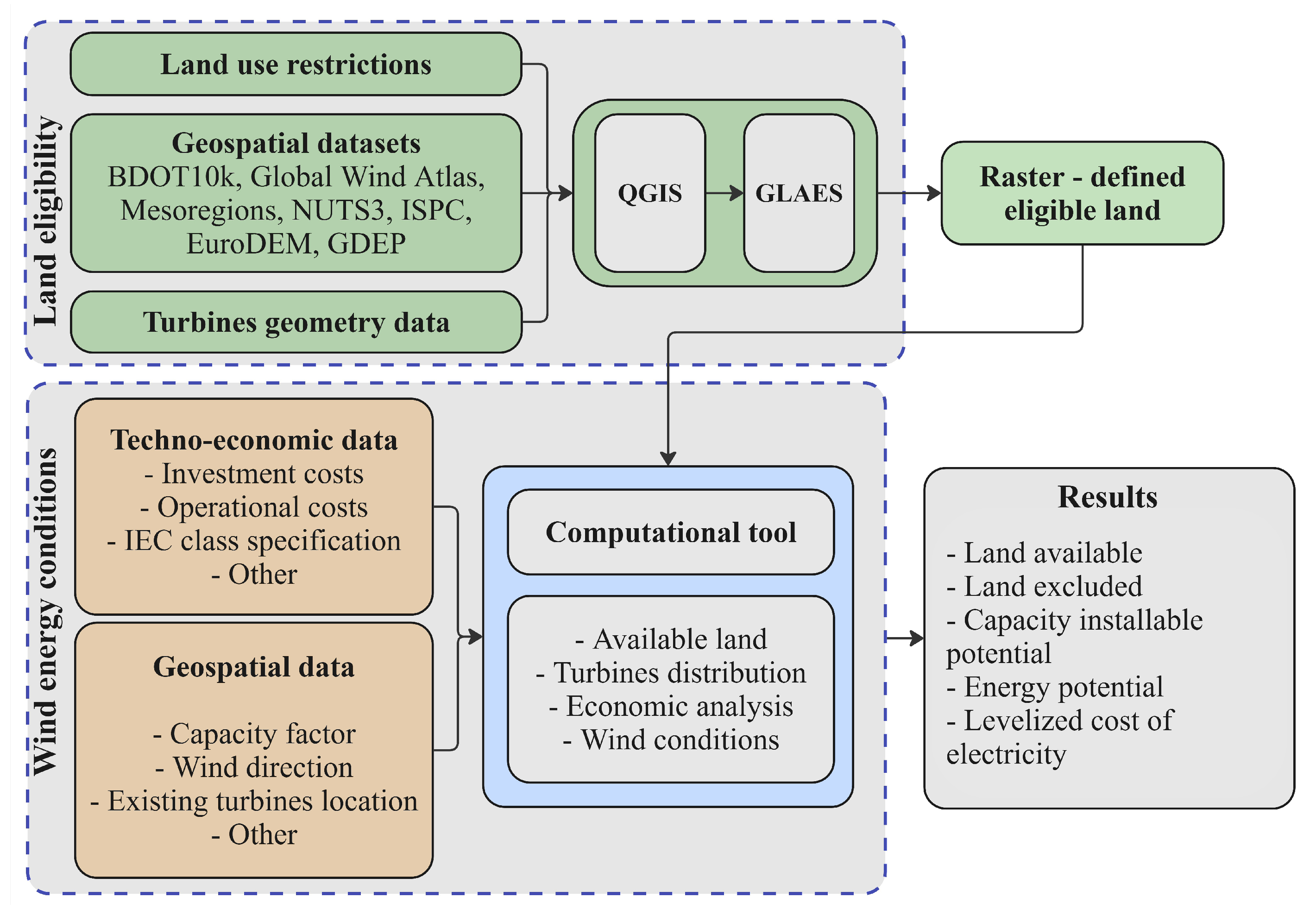
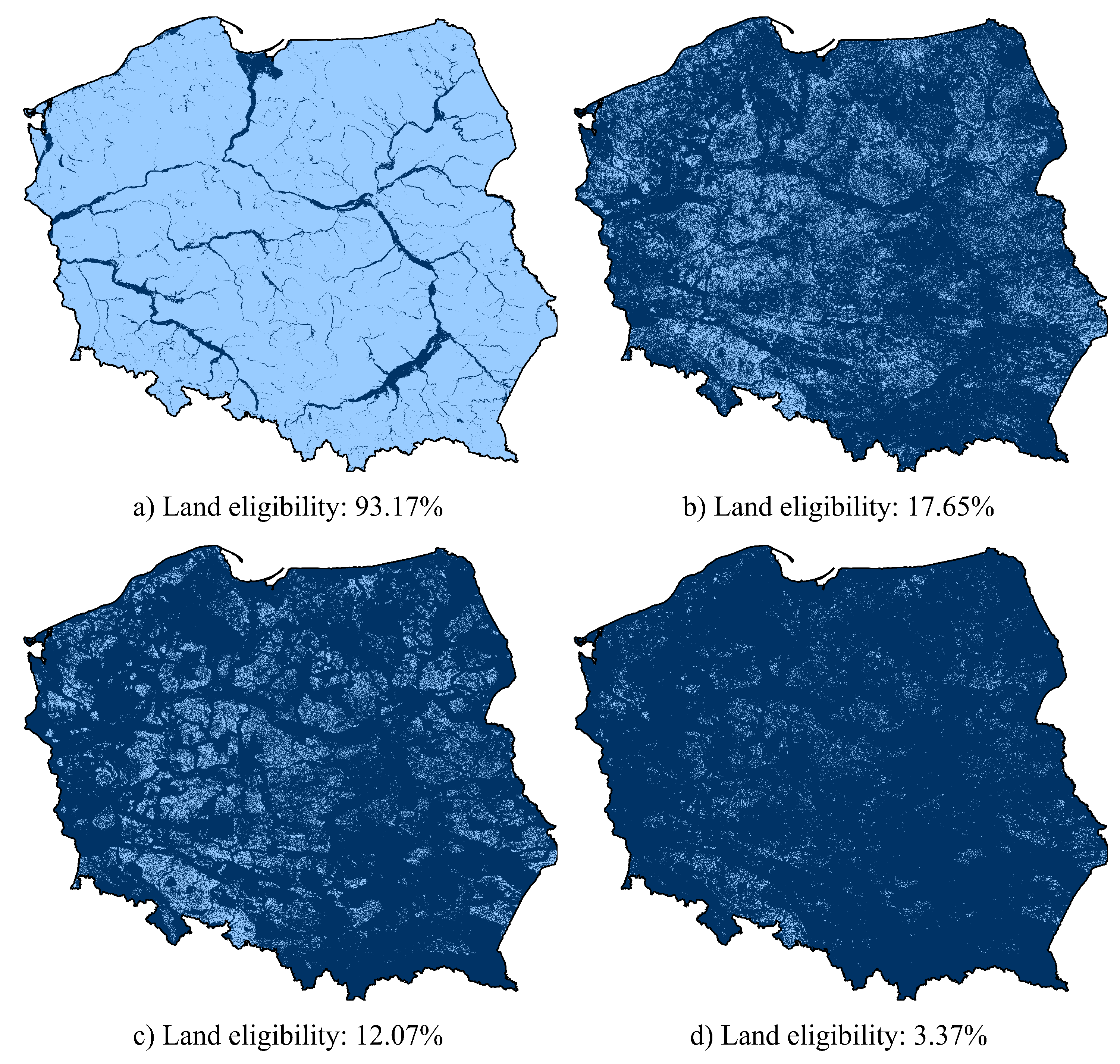

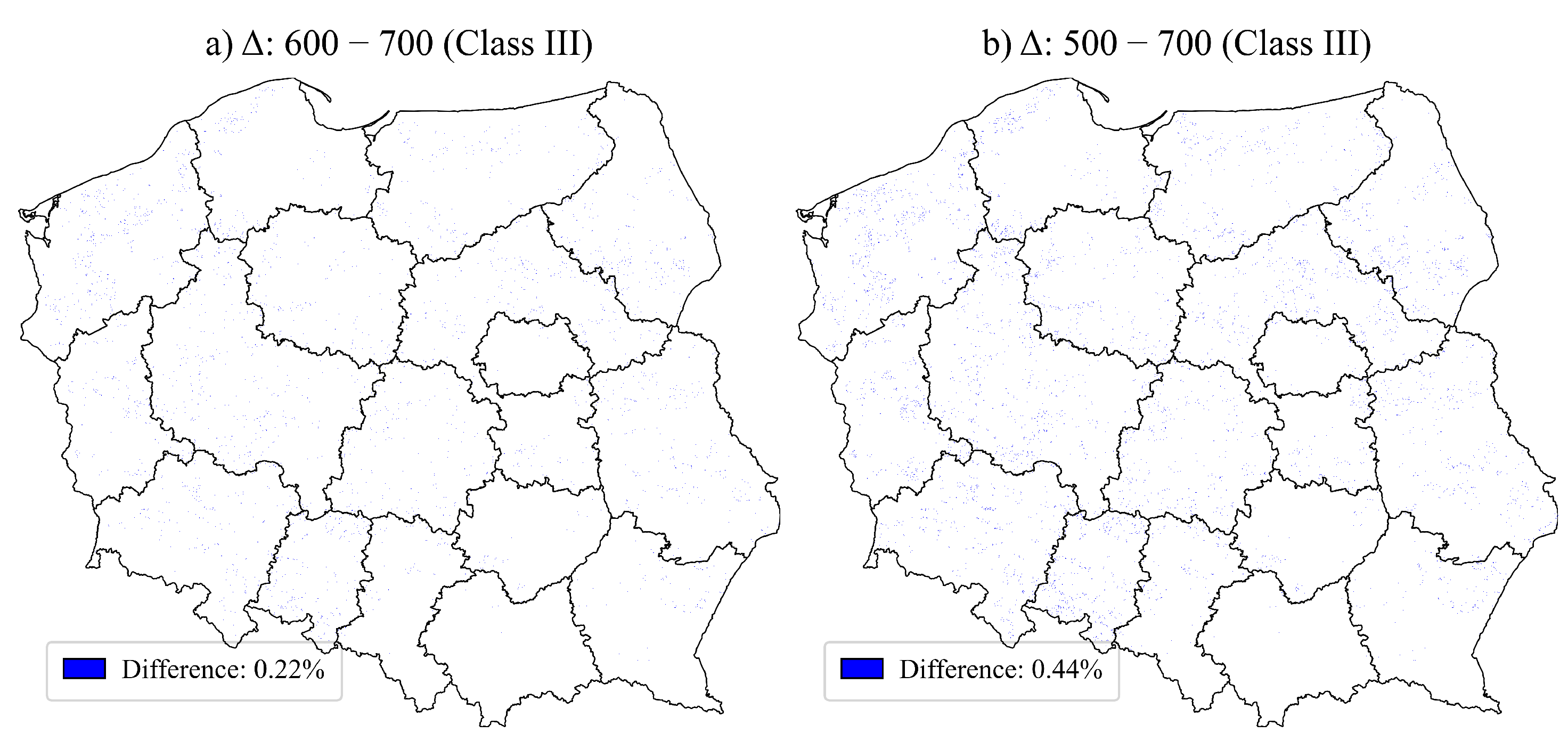
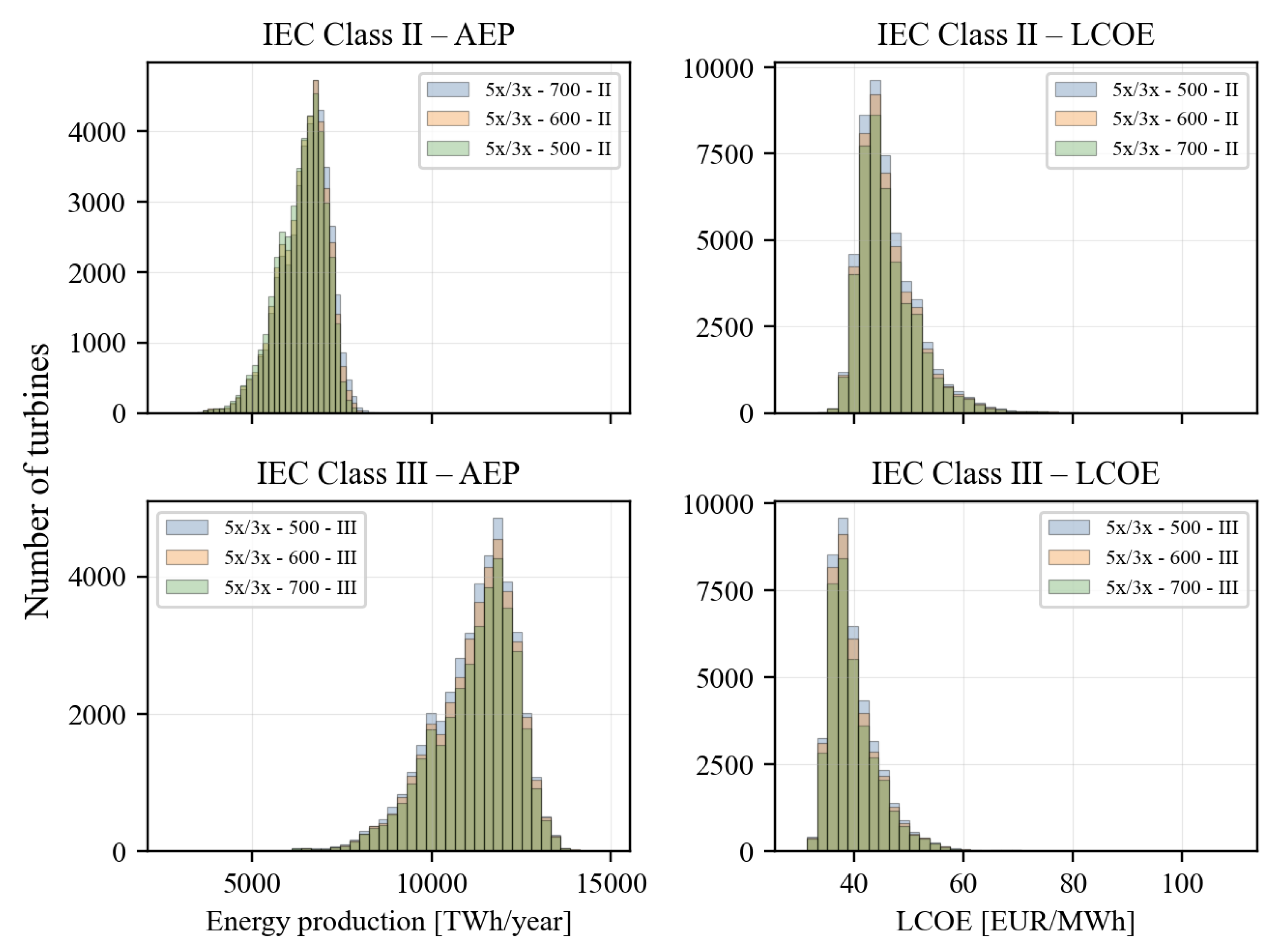
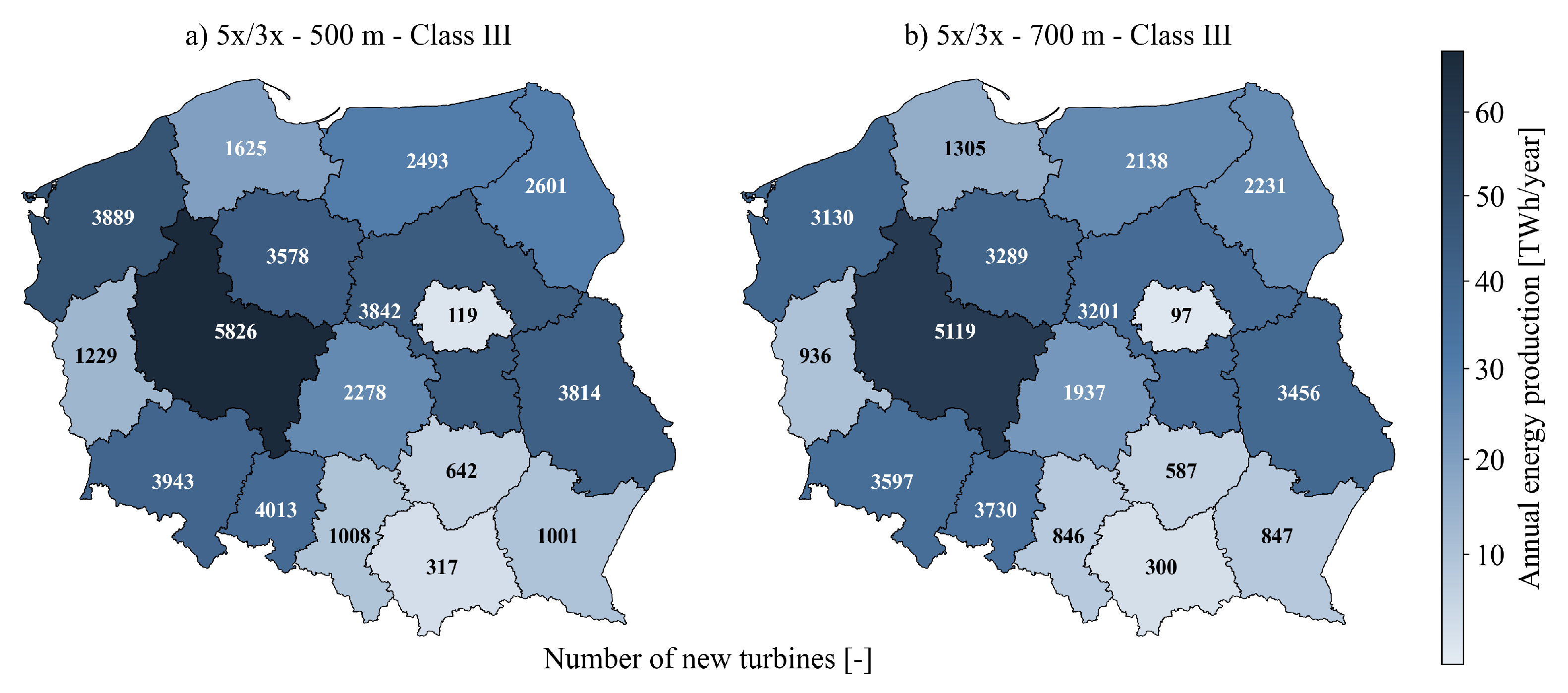
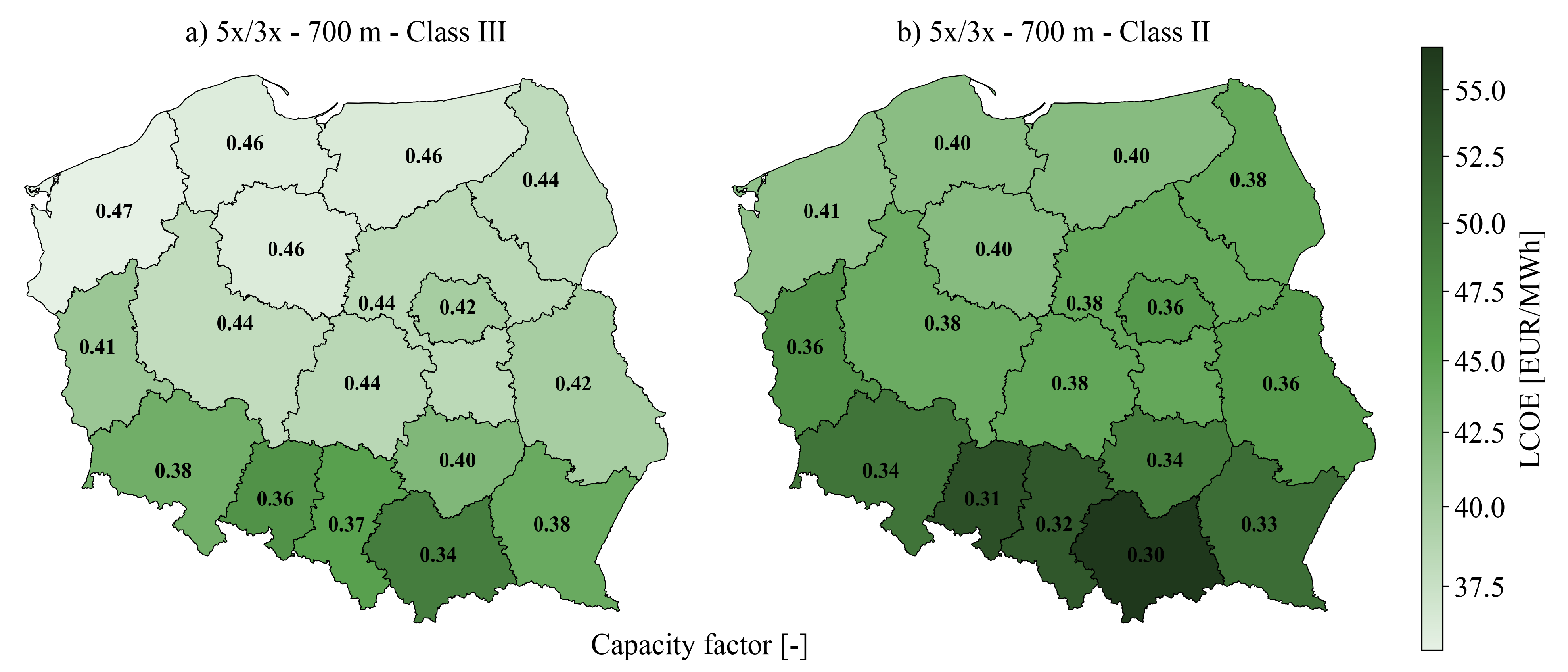
| GIS Layer | Reference | Buffer Distance [m] |
|---|---|---|
| Existing wind turbines | [35] | 5× rotor diameter |
| Flood hazard areas | [39] | 0 |
| Terrain slope (>17°) | [40] | 0 |
| Elevation (>2000 m) | [40] | 0 |
| Forests (woodlands, groves) | [35] | Rotor diameter |
| Inland waters | [35] | 100 |
| Wetlands | [35] | 100 |
| Reeds | [35] | 0 |
| Rivers | [35] | 100 |
| Streams, brooks, or creeks | [35] | 0 |
| Canals and drainage ditches | [35] | 0 |
| Permanent crops | [35] | Rotor diameter |
| Roads (motorways, expressways, main roads, local roads) | [35] | 50 |
| Airports, airfields | [35] | 3000 |
| Excavation and dumping sites | [35] | 200 |
| Tall technical structures (excluding power poles and wind turbines) | [35] | Rotor diameter |
| Military training areas | [35] | 500 |
| Extra-high-voltage power lines | [35] | Max (3× rotor diameter, 2× total turbine height) |
| High-voltage power lines | [35] | Rotor diameter |
| Residential buildings | [35] | Scenario-based |
| Non-residential buildings | [35] | 700 |
| Natural monuments | [41] | Rotor diameter |
| National parks | [41] | 10× total turbine height |
| Landscape parks | [41] | Rotor diameter |
| Nature reserves | [41] | 500 |
| Protected landscape areas | [41] | Rotor diameter |
| Natura 2000 sites (habitats and bird areas) | [41] | Rotor diameter |
| Natural-landscape complexes | [41] | Rotor diameter |
| Documentary sites | [41] | Rotor diameter |
| Ecological sites | [41] | Rotor diameter |
| Ecological corridors | [41] | Rotor diameter |
| Other small areas (<4 ha) | - | 0 |
| Wind speed (<4 m/s) | [42] | 0 |
| Capacity factors for turbine classes | [42] | - |
| Parameter | Value | References |
|---|---|---|
| CAPEX [EUR/kW] | 1695 | [29] |
| FCR [%] | 6.5 | [29] |
| OPEX [EUR/kW/year] | 37 | [29] |
| Turbine rotor diameter (for turbine IEC class II/III) [m] | 126/136 | [42] |
| Turbine hub height (for turbine IEC class II/III) [m] | 100/100 | [42] |
| Reference turbine capacity (for turbine IEC class II/III) [MW] | 2/3 | [46] |
| Prevailing wind direction [-] | West | [25,47] |
| Distance Between Turbines | Distance from Residential Buildings [m] | Turbine Class |
|---|---|---|
| 5× rotor diameter (for the prevailing wind direction), 3× rotor diameter (for the perpendicular direction) | 500 | II |
| 600 | ||
| 8× rotor diameter (for the prevailing wind direction), 4× rotor diameter (for the perpendicular direction) | 700 | III |
| Scenario (Turbine Spacing Rule -Distance from Residential Buildings -Turbine Class) | Share of Eligible Land in the Total Area of Poland [%] | Number of Installed Turbines [-] | Total Installed Capacity of New Turbines [GW] | Total Annual Energy Production [TWh] | LCOE [EUR/ MWh] |
|---|---|---|---|---|---|
| 5×/3×-700-II | 3.25 | 43,712 | 87.4 | 282.2 | 45.61 |
| 8×/4×-700-II | 20,160 | 40.3 | 130.1 | 45.63 | |
| 5×/3×-600-II | 3.48 | 46,805 | 93.6 | 301.8 | 45.65 |
| 8×/4×-600-II | 21,836 | 43.7 | 140.7 | 45.68 | |
| 5×/3×-500-II | 3.72 | 50,205 | 100.4 | 323.4 | 45.70 |
| 8×/4×-500-II | 23,377 | 46.8 | 150.4 | 45.75 | |
| 5×/3×-700-III | 3.11 | 36,751 | 110.3 | 411.5 | 39.44 |
| 8×/4×-700-III | 16,722 | 50.2 | 187.4 | 39.40 | |
| 5×/3×-600-III | 3.33 | 39,702 | 119.1 | 444.6 | 39.44 |
| 8×/4×-600-III | 17,976 | 53.9 | 201.4 | 39.42 | |
| 5×/3×-500-III | 3.55 | 42,228 | 126.7 | 472.0 | 39.51 |
| 8×/4×-500-III | 18,934 | 56.8 | 211.6 | 39.50 |
Disclaimer/Publisher’s Note: The statements, opinions and data contained in all publications are solely those of the individual author(s) and contributor(s) and not of MDPI and/or the editor(s). MDPI and/or the editor(s) disclaim responsibility for any injury to people or property resulting from any ideas, methods, instructions or products referred to in the content. |
© 2025 by the authors. Licensee MDPI, Basel, Switzerland. This article is an open access article distributed under the terms and conditions of the Creative Commons Attribution (CC BY) license (https://creativecommons.org/licenses/by/4.0/).
Share and Cite
Benalcazar, P.; Trzeciok, M.; Kamiński, J. A GIS-Based Framework for Evaluating Technical and Economic Prospects of Onshore Wind Energy: Case Study of Poland. Energies 2025, 18, 6230. https://doi.org/10.3390/en18236230
Benalcazar P, Trzeciok M, Kamiński J. A GIS-Based Framework for Evaluating Technical and Economic Prospects of Onshore Wind Energy: Case Study of Poland. Energies. 2025; 18(23):6230. https://doi.org/10.3390/en18236230
Chicago/Turabian StyleBenalcazar, Pablo, Magdalena Trzeciok, and Jacek Kamiński. 2025. "A GIS-Based Framework for Evaluating Technical and Economic Prospects of Onshore Wind Energy: Case Study of Poland" Energies 18, no. 23: 6230. https://doi.org/10.3390/en18236230
APA StyleBenalcazar, P., Trzeciok, M., & Kamiński, J. (2025). A GIS-Based Framework for Evaluating Technical and Economic Prospects of Onshore Wind Energy: Case Study of Poland. Energies, 18(23), 6230. https://doi.org/10.3390/en18236230









